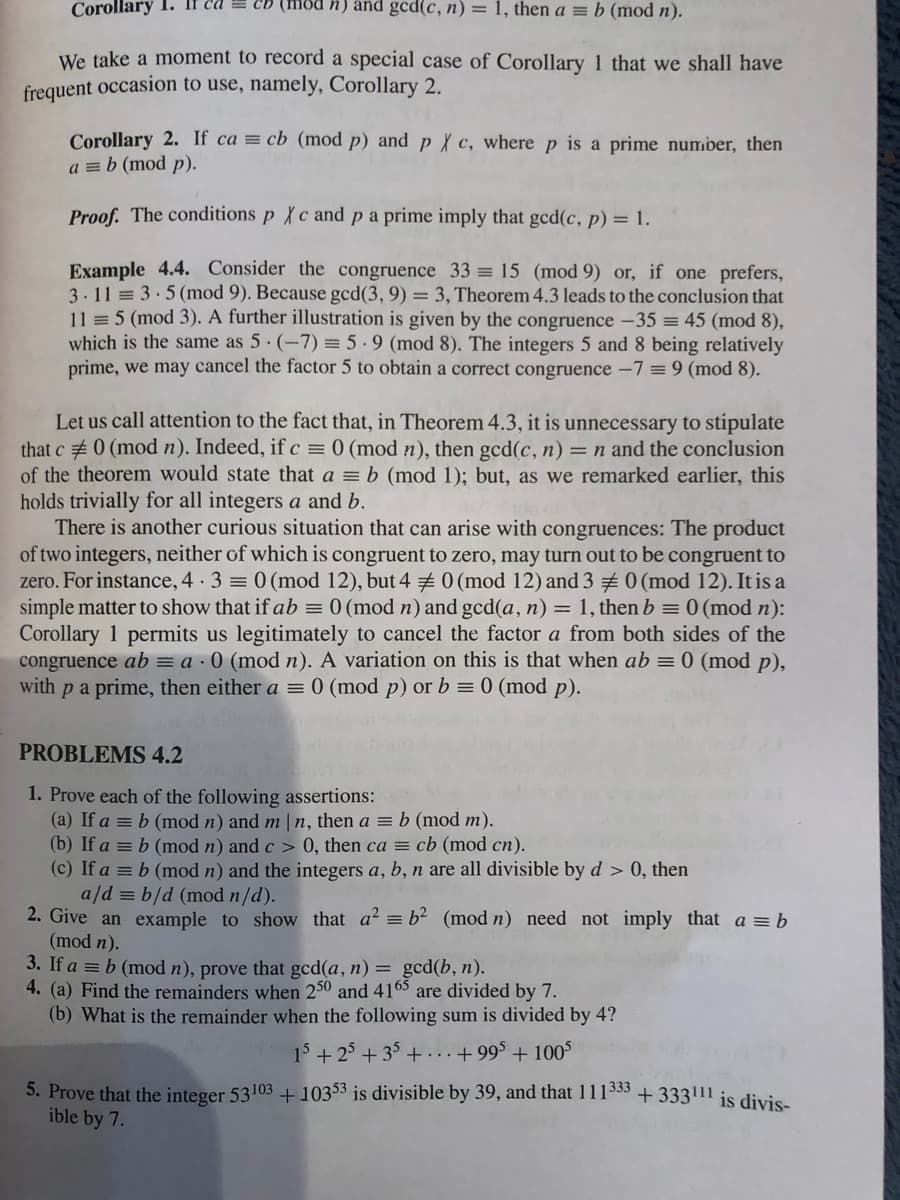3. If a = b (mod n), prove that gcd(a, n) = gcd(b, n). 4. (a) Find the remainders when 250 and 4165 are divided by 7. (b) What is the remainder when the following sum is divided by 4? 15 +25 +35+ .. +99° + 1005
3. If a = b (mod n), prove that gcd(a, n) = gcd(b, n). 4. (a) Find the remainders when 250 and 4165 are divided by 7. (b) What is the remainder when the following sum is divided by 4? 15 +25 +35+ .. +99° + 1005
Elements Of Modern Algebra
8th Edition
ISBN:9781285463230
Author:Gilbert, Linda, Jimmie
Publisher:Gilbert, Linda, Jimmie
Chapter2: The Integers
Section2.4: Prime Factors And Greatest Common Divisor
Problem 18E
Related questions
Concept explainers
Contingency Table
A contingency table can be defined as the visual representation of the relationship between two or more categorical variables that can be evaluated and registered. It is a categorical version of the scatterplot, which is used to investigate the linear relationship between two variables. A contingency table is indeed a type of frequency distribution table that displays two variables at the same time.
Binomial Distribution
Binomial is an algebraic expression of the sum or the difference of two terms. Before knowing about binomial distribution, we must know about the binomial theorem.
Topic Video
Question
4

Transcribed Image Text:Corollary 1.
Cb (mod n) and gcd(c, n) = 1, then a = b (mod n).
We take a moment to record a special case of Corollary 1 that we shall have
frequent occasion to use, namely, Corollary 2.
Corollary 2. If ca = cb (mod p) and p X c, where p is a prime number, then
a = b (mod p).
Proof. The conditions p Xc and p a prime imply that gcd(c, p) = 1.
Example 4.4. Consider the congruence 33 = 15 (mod 9) or, if one prefers,
3.11 = 3.5(mod 9). Because gcd(3, 9) = 3, Theorem 4.3 leads to the conclusion that
11 = 5 (mod 3). A further illustration is given by the congruence -35 = 45 (mod 8),
which is the same as 5· (-7) = 5· 9 (mod 8). The integers 5 and 8 being relatively
prime, we may cancel the factor 5 to obtain a correct congruence -7 = 9 (mod 8).
Let us call attention to the fact that, in Theorem 4.3, it is unnecessary to stipulate
that c 0 (mod n). Indeed, if c = 0 (mod n), then gcd(c, n) = n and the conclusion
of the theorem would state that a = b (mod 1); but, as we remarked earlier, this
holds trivially for all integers a and b.
There is another curious situation that can arise with congruences: The product
of two integers, neither of which is congruent to zero, may turn out to be congruent to
zero. For instance, 4 3 = 0 (mod 12), but 4 # 0 (mod 12) and 3 #0 (mod 12). It is a
simple matter to show that if ab = 0 (mod n) and gcd(a, n) = 1, then b = 0 (mod n):
Corollary 1 permits us legitimately to cancel the factor a from both sides of the
congruence ab = a 0 (mod n). A variation on this is that when ab = 0 (mod p),
with p a prime, then either a = 0 (mod p) or b = 0 (mod p).
PROBLEMS 4.2
1. Prove each of the following assertions:
(a) If a = b (mod n) and m |n, then a = b (mod m).
(b) If a = b (mod n) and c > 0, then ca = cb (mod cn).
(c) If a = b (mod n) and the integers a, b, n are all divisible by d > 0, then
a/d = b/d (mod n/d).
2. Give an example to show that a2 = b² (mod n) need not imply that a = b
(mod n).
3. If a = b (mod n), prove that gcd(a, n) = gcd(b, n).
4. (a) Find the remainders when 250 and 4165 are divided by 7.
(b) What is the remainder when the following sum is divided by 4?
15 + 25 + 35 + ...+99$ + 100$
5. Prove that the integer 53103 + 10353 is divisible by 39, and that 111333 +33311 ;s divis
ible by 7.
Expert Solution
This question has been solved!
Explore an expertly crafted, step-by-step solution for a thorough understanding of key concepts.
Step by step
Solved in 2 steps with 1 images

Knowledge Booster
Learn more about
Need a deep-dive on the concept behind this application? Look no further. Learn more about this topic, advanced-math and related others by exploring similar questions and additional content below.Recommended textbooks for you

Elements Of Modern Algebra
Algebra
ISBN:
9781285463230
Author:
Gilbert, Linda, Jimmie
Publisher:
Cengage Learning,

Algebra & Trigonometry with Analytic Geometry
Algebra
ISBN:
9781133382119
Author:
Swokowski
Publisher:
Cengage

Elements Of Modern Algebra
Algebra
ISBN:
9781285463230
Author:
Gilbert, Linda, Jimmie
Publisher:
Cengage Learning,

Algebra & Trigonometry with Analytic Geometry
Algebra
ISBN:
9781133382119
Author:
Swokowski
Publisher:
Cengage